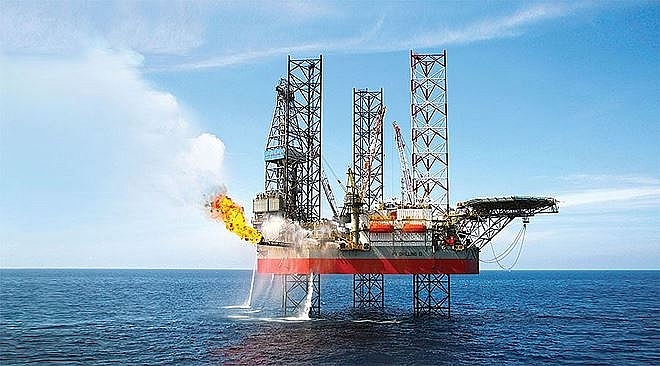Diverging outcomes anticipated among listed petroleum firms
 |
| Petroleum exploration and extraction firms anticipates a shortfall in their exploitation output during 2018-2020 |
According to the US Energy Information Administration (EIA)’s July 2018 report, the price of Brent Crude oil is expected to fetch around $73 per barrel in the year’s second half and will go down to $69 per barrel next year.
Brent Crude price averaged $71 per barrel in the first half, a 35 per cent jump on-year and 23 per cent more than in early 2018. It was also up 29 per cent compared to the base price of $55 per barrel most petroleum firms applied when working on their 2018 business plans.
KIS Vietnam Securities JSC estimated that by virtue of rising oil prices, the revenue and profit figures of most petroleum firms listed on the Vietnamese stock exchange went up by 26-36 per cent in the first half of this year compared to the same period in 2017.
Hoang Huy, KIS Vietnam’s head of Research, said that the current oil price has surpassed the break-even point of state-owned oil and gas group PetroVietnam, which is the parent company of many petroleum firms operating in the sector’s upstream, medium, and downstream areas.
With upbeat performance, PetroVietnam contributed more than VND61.8 trillion ($2.73 billion) to the state coffers in the first seven months of this year, a 46 per cent jump over the projection.
Albeit the oil price is expected to hold on to this growth momentum in the second half, market analysts, however, expect divergence in the profit pictures of listed petroleum firms based on their fields of operation.
Upstream firms who engage in exploration and extraction activities, anticipate a shortfall in exploitation output during 2018-2020.
Besides, falling service price and modest work volume would also exaggerate the situation. KIS Vietnam figures show that in the first half of this year, PetroVietnam reported 7.13 million tonnes of exploitation output, down 9.7 per cent on-year, and the fall would continue in the second half.
Meanwhile, the situation is expected to be more upbeat for businesses involved in the medium and downstream segments.
For instance, in the downstream segment Southern Gas Trading JSC (PGS) said that at $55 per barrel, the company has set VND5.92 trillion ($262 million) revenue and VND135.9 billion ($60 million) pre-tax profit targets for this year.
In the first half, PGS reached VND3.01 trillion ($133 million) in revenue and VND61.3 billion ($2.7 million) in pre-tax profit, equal to 51 and 45 per cent of its full-year projection. In the second half, the company aims to reach VND3.28 trillion ($145.3 million) in revenue and VND74.9 billion ($3.3 million) in pre-tax profit, up 6 per cent against the revenue target and reaching the pre-tax profit target set for the whole year.
An executive at PetroVietnam Oil Corporation (PV OIL) said petroleum distribution firms like them could only post positive business results once the oil price was high and stable.
| The exchange rate also impacts petroleum firms’ performance, especially when it is trending upwards, as it is doing now. |
The exchange rate also impacts petroleum firms’ performance, especially when it is trending upwards, as it is doing now.
Analysts assumed that firms borrowing dollar-denominated loans without dollar income sources will be at a disadvantage amidst the rising exchange rate, whereas the implications will be insignificant to firms having dollar income sources.
Trinh Duy Viet, head of Research at DongA Bank Securities JSC, assumed that upstream businesses will directly benefit from the rising oil price in the latter months of 2018, while those in the medium and downstream segments will benefit indirectly through accelerated investment in petroleum projects.
The business outcomes in the second half, therefore, will diverge and upstream firms will see better profits than those in the medium and downstream segments.
“Regarding the shares of petroleum construction companies, a sharp price hike in the second half would be unlikely, but several tickers could still appeal to investors, helping to drive up the market,” Viet opined.
What the stars mean:
★ Poor ★ ★ Promising ★★★ Good ★★★★ Very good ★★★★★ Exceptional
 Tag:
Tag:
Related Contents
Latest News
More News
- Businesses ramp up production as year-end orders surge (December 30, 2025 | 10:05)
- Vietjet chairwoman awarded Labour Hero title (December 29, 2025 | 13:06)
- How to unlock ESG value through green innovation (December 29, 2025 | 10:03)
- AI reshapes media and advertising industry (December 29, 2025 | 08:33)
- FPT and GELEX sign deal to develop blockchain tech for global markets (December 29, 2025 | 08:29)
- Vietnam’s GDP forecast to grow by 9 per cent in 2026 (December 29, 2025 | 08:29)
- Women entrepreneurs are key to Vietnam’s economic growth (December 29, 2025 | 08:00)
- Vietnam's top 500 value-creating enterprises announced (December 27, 2025 | 08:00)
- The PAN Group shaping a better future with ESG strategy (December 26, 2025 | 09:00)
- Masan Consumer officially lists on HSX, marking the next phase of value creation (December 25, 2025 | 13:20)





























 Mobile Version
Mobile Version